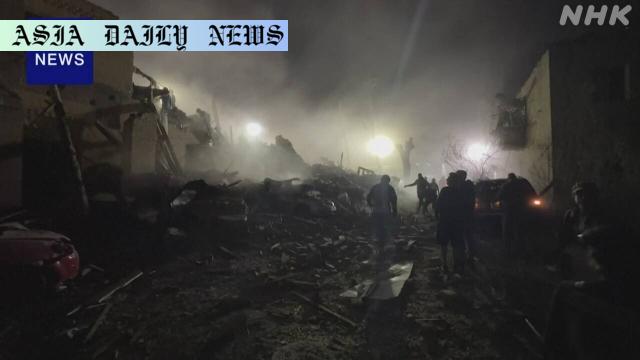Kyiv Attack: Russian missiles and drones claimed nine lives while injuring over 60 in a destructive strike on Ukraine’s capital.
Russian missiles and drones hit Kyiv, killing nine people.
More than 60 civilians are injured; efforts to rescue the buried continue.
The attack caused severe destruction to houses and triggered fires.
A Russian drone also killed nine in southern Ukraine the day before.

Tragic Attack on Kyiv: Nine Lives Lost
On Thursday morning, Ukraine’s capital Kyiv woke up to one of the most devastating missile and drone attacks in recent times. The combined assault, carried out by Russian forces, claimed at least nine lives and left over 60 people wounded, according to official statements released by Ukrainian authorities. The attack also caused extensive property damage, leaving neighborhoods in western and southern Kyiv in ruins. Mayor Vitali Klitschko confirmed the widespread impact across multiple districts, highlighting the destruction left in the wake of this offensive. As emergency crews continue their efforts, the grim task of searching for survivors and recovering bodies from under the rubble unfolds.
This attack comes as part of a continued offensive by Russian forces against Ukraine. It has put the spotlight on the mounting civilian toll in a war that shows no signs of abating. Many families in Kyiv are grappling with the loss of loved ones and the trauma of this sudden disaster. Ukraine’s State Emergency Service confirmed that fires ignited across several affected neighborhoods, causing further complications in rescue missions. The agency reported significant damage to housing structures, with some areas reduced to little more than debris. The emergency services continue an exhaustive search for individuals who may be trapped.
More Destruction Across Ukraine
The damage inflicted on Kyiv follows another tragic incident in southern Ukraine, where a Russian drone struck a bus on Wednesday, killing nine individuals. Together, these two consecutive attacks have intensified the sense of insecurity and urgency regarding efforts to safeguard Ukraine’s civilian population. Despite ongoing international advocacy for peace, these incidents underline significant challenges in de-escalating the crisis. Meanwhile, Ukraine presses ahead with its efforts to defend its sovereignty and communities in the face of such indiscriminate violence.
The attacks also signal the persistence of Russian military aggression despite diplomatic efforts led by global powers, including the United States, to bring about a peaceful resolution to the conflict. The coordinated assault in Kyiv, involving both missiles and drones, encapsulates the deteriorating situation as the war continues to spiral. As the world watches, the latest episodes in this conflict reiterate the profound humanitarian cost involved in prolonged, large-scale confrontations.
The Broader Context
These events highlight both the immediate and long-term implications of ongoing military conflicts for civilian populations. As homes crumble into rubble and families mourn the loss of loved ones, the overarching question concerns the feasibility of peace negotiations amidst escalating violence. The unprecedented use of drones and other military equipment underscores the increasingly sophisticated nature of modern warfare, which leaves little room for civilians to seek shelter or find safety. Moreover, the impact ripples beyond immediate casualties to challenge the social and economic fabric of affected communities, which are left to grapple with loss, displacement, and recovery.
Ukraine’s struggles bring forward urgent considerations about the efficacy of international mechanisms in resolving such conflicts. How long can civilians endure? And what role do global alliances play in either deterring aggressions or intervening in humanitarian crises? Although diplomatic channels remain open, the incidents at Kyiv and southern Ukraine stand as stark reminders of the gap between negotiations on paper and realities on the ground.
Commentary
Reflecting on the Kyiv Attack: Unfolding Tragedy
It is deeply sorrowful to witness the violence inflicted on Kyiv and its residents during the recent Russian attack. News of nine lives lost and over 60 people injured paints a grim picture of the increasing toll of this conflict. As each day passes, one must grapple with the human cost of a geopolitical standoff that seems far from resolution.
The impact of events like these ripple outwards, far beyond the immediate areas struck. With homes reduced to rubble and lives forever changed, the resilience of Ukraine’s people is severely tested. While the world observes from afar, many are left wondering how long this humanitarian crisis will continue to worsen. It calls into question the limits of modern diplomacy and the international community’s ability to effectively intervene.
The Civilian Cost of Modern Warfare
What is most striking about such tragedies is the disproportionate impact they have on civilians. The deliberate targeting of residential areas with sophisticated machinery adds a new dimension to warfare, leaving ordinary citizens defenseless against the threat. These bombardments not only shatter buildings but also break the emotional and social structures of communities. The sacrifices being made, particularly by families mourning their dead, highlight how the ordinary man, woman, or child bears the brunt of political conflicts.
As the war evolves, the focus shifts more towards the adaptability and immediate reaction of civilian populations who must navigate life-and-death situations daily. While governments pledge aid and intervention from afar, the lived experiences on the ground remain a harrowing reminder of how powerless one can feel amid larger forces at play.
What Lies Ahead?
Looking ahead, the global community has a critical role to play in fostering genuine peace negotiations that yield tangible results. The ongoing dialogue between Russia, Ukraine, and their allies must go beyond rhetoric, aiming instead to secure safety, stability, and a comforting hand to those most deeply impacted by this war. Without such tangible interventions, the cycle of violence and loss will continue, further eroding hopes for eventual peace.


